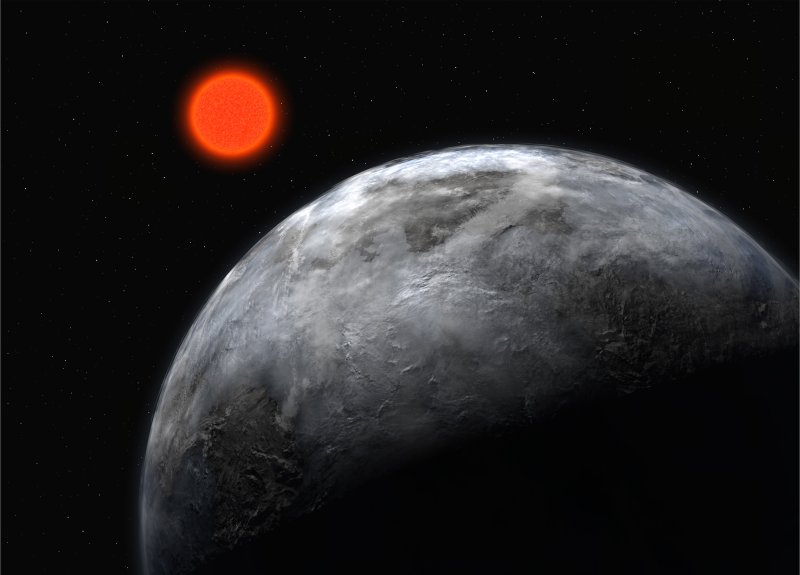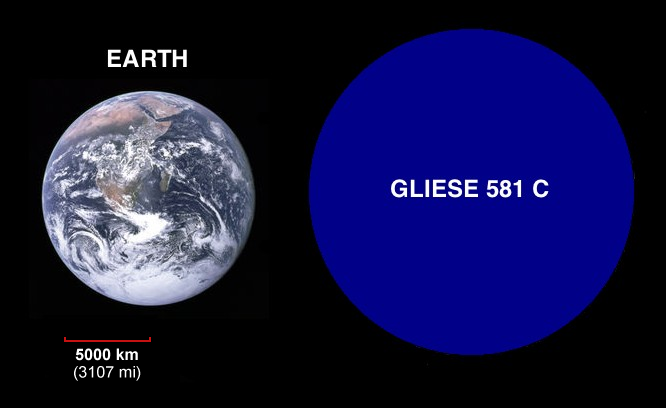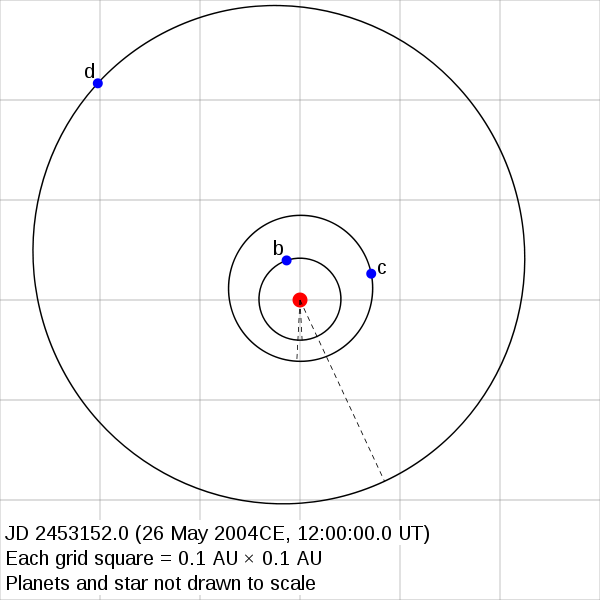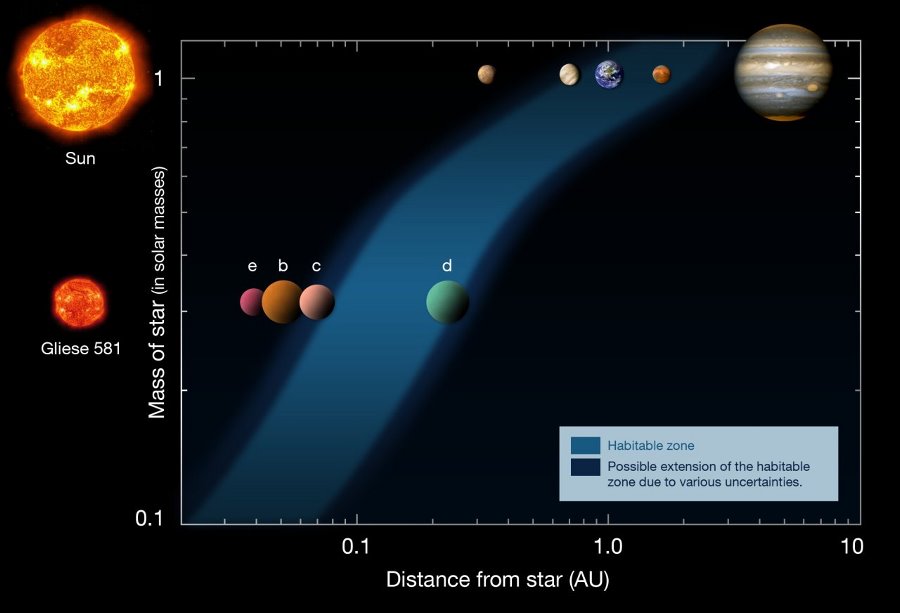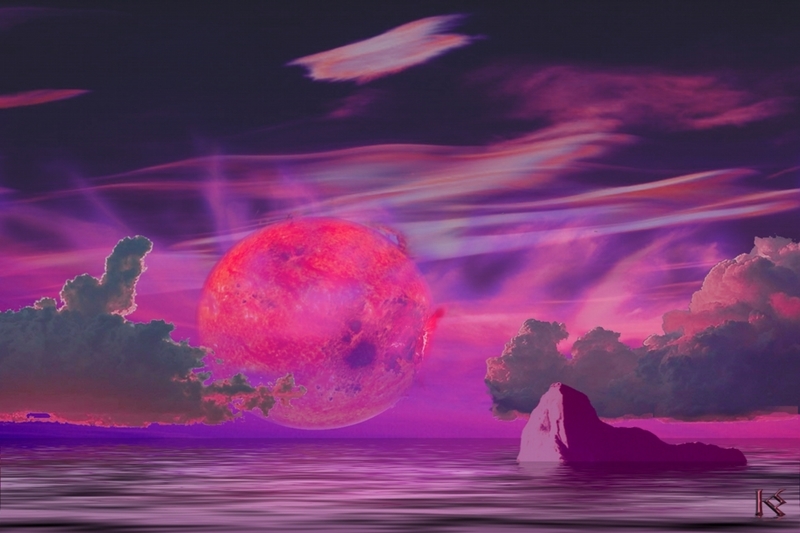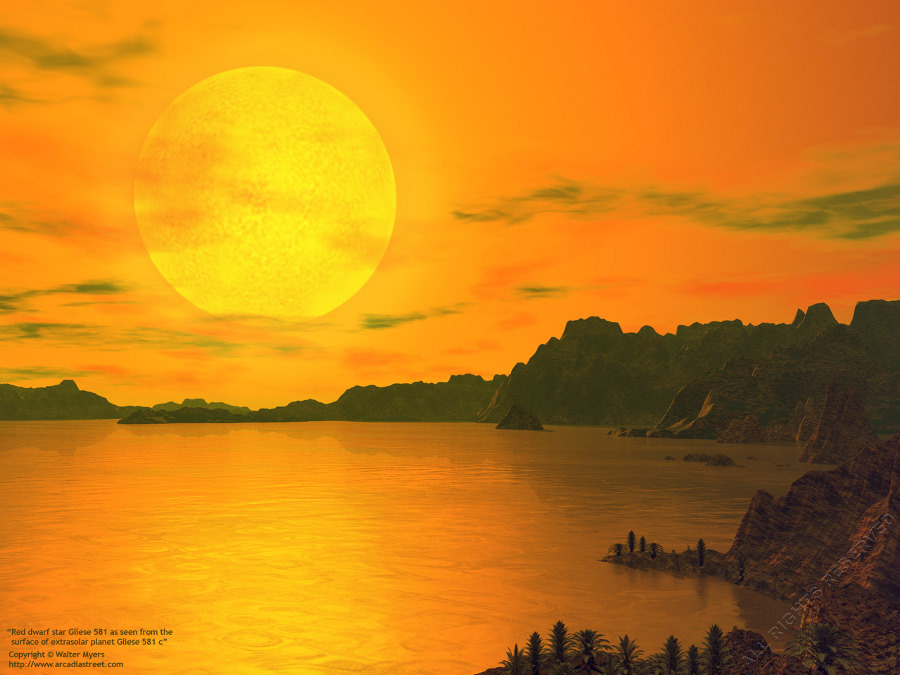|
Extra Solar Planets New Planets Discovered |
|||||
|
The Earth-like Planet Gliese 581c ..
Artist's impression of the five-Earth
mass planet, Gliese 581c, found in the habitable
zone around the red dwarf
Gliese 581, with the instrument HARPS on the ESO
3.6-m telescope. Credit:
ESO
|
|||||
|
Gliese 581 c
or Gl 581 c is a "Super-Earth",
a large extrasolar terrestrial planet, orbiting the
red dwarf star Gliese
581.[3]Assuming that the planet's mass is close to
the lower limit determined
by radial velocity measurements (the true mass is
unknown), it was the
smallest known extrasolar planet around a main
sequence star, but on April
21, 2009, another planet orbiting Gliese 581, Gliese
581 e, was announced
with an approximate mass of 1.9 earth masses, which
is now the smallest
known extrasolar planet around a main sequence
star.[4] Gliese 581 c generated
interest because it was initially reported to be the
first potentially
Earth-like planet in the habitable zone of its star,
with a temperature
right for liquid water on its surface, and by
extension, potentially capable
of supporting extremophile forms of Earth-like
life.[3][5] However, further
research on the potential effects of the planetary
atmosphere casts doubt
upon the habitability of Gliese 581 c and indicates
that the fourth planet
in the system, Gliese 581 d, is a better candidate
for habitability.[1][6][7]
In astronomical terms, the Gliese 581 system is
relatively close to Earth,
at 20.3 light years (192 trillion km or 119 trillion
miles) in the direction
of the constellation of Libra.[8][9] This distance,
along with the declination
and right ascension coordinates, give its exact
location in our galaxy.
It is identified as Gliese 581 by its number in the
Gliese
Catalogue of Nearby Stars; it is the 87th
closest known star system
to the Sun.[10]
Contents:
The discovery of the planet by the team of Stéphane Udry University of Geneva's Observatory in Switzerland was announced on April 24, 2007. [3]The team used the HARPS instrument (an echelle spectrograph) on the European Southern Observatory 3.6 m Telescope in La Silla, Chile, and employed the radial velocity technique to identify the planet's influence on the star. The Canadian-built MOST space telescope was used to conduct a follow-up study over the next six weeks. No transit was detected over this time, so a direct measurement of the planet has not yet been possible; however, the star's apparent magnitude changed very little, indicating that it provides a stable source of light and heat to Gliese 581 c.[11] The team released a paper of their findings dated April 27, 2007, published in the July, 2007 journal Astronomy and Astrophysics. [1]In the paper they also announced the discovery of another planet in the system, Gliese 581 d, with a minimum mass of 7.7 Earth masses and a semi-major axis of 0.25 astronomical units.
The existence of Gliese 581 c and its mass have been measured by the radial velocity method of detecting extrasolar planets. The mass of a planet is calculated by the small periodic movements around a common centre of mass between the host star Gliese 581 and its planets. Because the "wobbling" of Gliese 581 is a result of all planets in its system, the calculation of the mass of Gliese 581c depends on the presence of other planets in the Gliese 581 system and on the inclination of the orbital plane with respect to Earth. Using the known minimum mass of the previously detected Gliese 581 b, and assuming the existence of Gliese 581 d, Gliese 581 c has a mass at least 5.073 times that of Earth.[2] The mass of the planet cannot be very much larger than this or the system would be dynamically unstable.[1] Dynamical simulations of the Gliese 581 system which assume the orbits of the planets are coplanar indicate that for inclinations less than about 10° the system would be unstable.[2] For Gliese 581 c, this corresponds to an upper bound of about 29 Earth masses, or about 70% more massive than Neptune.[12] Since Gliese 581 c has not been detected directly, there are no measurements of its radius. Furthermore, the radial velocity method used to detect it only puts a lower limit on the planet's mass, which means theoretical models of planetary radius and structure can only be of limited use. However, assuming a random orientation of the planet's orbit, the true mass is likely to be close to the measured minimum mass. Assuming that the true mass is the minimum mass, the radius may be calculated using various models. For example, if Gliese 581 c is a rocky planet with a large iron core, it should have a radius approximately 50% larger than that of Earth, according to Udry's team.[1][13] Gravity on such a planet's surface would be approximately 2.24 times as strong as on Earth. However, if Gliese 581 c is an icy and/or watery planet, its radius would be less than 2 times that of Earth, even with a very large outer hydrosphere, according to density models compiled by Diana Valencia and her team for Gliese 876 d.[14] Gravity on the surface of such an icy and/or watery planet would be at least 1.25 times as strong as on Earth. They claim the real value of the radius may be anything between the two extremes calculated by density models outlined above.[15]
Other scientists' views differ. Sara Seager at MIT has speculated that Gliese 581 c and other five-Earth-mass planets could be:[16]
"cannonball" planets of solid iron. "gas dwarfs" mostly of helium and hydrogen. carbon-rich "diamond worlds" purely hot ice-VII worlds. purely carbon-monoxide worlds.
For comparison, the smallest confirmed diameter of a planet around a main-sequence star is that of COROT-7b, which is about 70% larger than Earth.
Note: This figure omits the most recently discovered planet in the system, Gliese 581 e . Assumptions:
The planetary orbits are drawn
in orthographic projection, as viewed from
directly above the plane of
the system so that the orbital direction is
anticlockwise. The dashed lines
are drawn between the star and the periastron
point of each planet, in
order to depict the relative orientation of the
orbits with respect to
each other. The position of each planet in its
orbit is calculated using
the time of periastron in the table in the Udry
paper, and are drawn at
a time chosen to be close to the start of the
Udry et al. radial velocity
observations, which are available here. This
time is chosen to minimise
the effects of both uncertainties in the orbital
parameters and potential
orbital evolution of the system.
The orbits of the Gliese 581 planetary system, prior to the discovery of Gliese 581 e. In the picture, Gliese 581 c is the second planet from the star. Gliese 581 c has an orbital period ("year") of 13 Earth days[8] and its orbital radius is only about 7% that of the Earth, about 11 million km[17], while the Earth is 150 million kilometres from the Sun[18]. Since the host star is smaller and colder than the Sun—and thus less luminous—this distance places the planet on the "warm" edge of the habitable zone around the star according to Udry's team.[1][13] Note that in astrophysics, the "habitable zone" is defined as the range of distances from the star at which a planet could support liquid water on its surface: it should not be taken to mean that the planet's environment would be suitable for humans, a situation which requires a more restrictive range of parameters. A typical radius for an M0 star of Gliese 581's age and metallicity is 0.00128 AU[19], against the sun's 0.00465 AU. This proximity means that the primary star should appear 3.75 times wider and 14 times larger in area for an observer on the planet's surface looking at the sky than the Sun appears to be from Earth's surface. Because of its small separation from Gliese 581, the planet has been generally considered to always have one hemisphere facing the star (only day), and the other always facing away (only night), or in other words being tidally locked.[20][21] Even then, the planet would undergo violent tidal flexing, because the orbital eccentricity is between 0.10 and 0.22.[2] Because tidal forces are stronger when the planet is close to the star, eccentric planets are expected to have a rotation period which is shorter than its orbital period, also called pseudo-synchronization.[22] An example of this effect is seen in Mercury, which is tidally locked in a 3:2 resonance, completing three rotations every two orbits. In any case, even in case of 1:1 tidal lock, the planet would undergo libration and the terminator would be alternatively lit and darkened during libration.[23] Models of the evolution of the planet's orbit over time suggest that heating resulting from this tidal locking may play a major role in the planet's geology. Models proposed by scientists predict that tidal heating could yield a surface heat flux about three times greater than the Jupiter's moon Io's, which could result in major geological activity such as volcanoes and plate tectonics.[24] The study of Gliese 581 c by the von Bloh et al. team has been quoted as concluding "The super-Earth Gl 581c is clearly outside the habitable zone, since it is too close to the star."[7] The study by Selsis et al. claims even "a planet in the habitable zone is not necessarily habitable" itself, and this planet "is outside what can be considered the conservative habitable zone" of the parent star, and further that if there was any water there and it was lost when the red dwarf was a strong X-ray and EUV emitter, it could have surface temperatures ranging from 700 K to 1000 K (427 to 727 °C).[6] Temperature speculations by other scientists are based on the temperature of (and heat from) the parent star Gliese 581 and have been calculated without factoring in the wide margin of error (96 °C/K) for the star's temperature of 3432 K to 3528 K.[25] Using the measured stellar luminosity of Gliese 581 of 0.013 times that of our Sun, it is possible to calculate Gliese 581 c's effective temperature a. k. a. black body temperature. (note: this probably differs from its surface temperature). According to Udry's team, the effective temperature for Gliese 581 c, assuming an albedo (reflectivity) such as Venus' (0.64), would be −3 °C (26.6 °F), and assuming an Earth-like albedo (0.296), then it would be 40 °C (104 °F),[1][8] a range of temperatures which overlaps with the range that water would be liquid at a pressure of 1 atmosphere. However, the effective temperature and actual surface temperature can be very different due to the greenhouse properties of the planetary atmosphere: for example, Venus has an effective temperature of 34.25 °C (93.65 °F), but a surface temperature of 463.85 °C (866.93 °F), a difference of about 430 °C (774 °F).[26] Studies of the habitability of Gliese 581's planets[7][27] conclude that Gliese 581 c is likely to suffer from a runaway greenhouse effect similar to that found on Venus, as such, is highly unlikely to be habitable. Nevertheless, this runaway greenhouse effect could be prevented by the presence of sufficient reflective cloud cover on the planet's day side.[28] Alternatively, if the surface were covered in ice, it would have a high albedo (reflectivity), and thus could reflect enough of the incident sunlight back into space to render the planet too cold for habitability, although this situation is expected to be unstable except for very high albedos greater than about 0.95: release of carbon dioxide by volcanic activity or of water vapor due to heating at the substellar point would trigger a runaway greenhouse effect.[29]
By refining the orbit of the
planet Gliese 581 d, first discovered in 2007, a
team of astronomers has
shown that it lies well within the habitable
zone, where liquid water oceans
could exist. This diagram shows the distances of
the planets in the Solar
System (upper row) and in the Gliese 581 system
(lower row), from their
respective stars (left). The habitable zone is
indicated as the blue area,
showing that Gliese 581 d is located inside the
habitable zone around its
low-mass red star.
Based on a
diagram by Franck
Selsis, Univ. of Bordeaux. - Credit ESO
Planetary habitable zones of the Solar System and the Gliese 581 system compared. Gliese 581 c is likely to lie outside the habitable zone.[7][30] No direct evidence has been found for water to be present, but it is probably not present in the liquid state. Techniques like the one used to measure the extrasolar planet HD 209458 b may in the future be used to determine the presence of water in the form of vapor in the planet's atmosphere, but only in the rare case of a planet with an orbit aligned so as to transit its star, which Gliese 581 c is not known to do. Theoretical models predict that volatile compounds such as water and carbon dioxide, if present, might evaporate in the scorching heat of the sunward side, migrate to the cooler night side, and condense to form ice caps. Over time, the entire atmosphere might freeze into ice caps on the night side of the planet. Alternatively, an atmosphere large enough to be stable would circulate the heat more evenly, allowing for a wider habitable area on the surface.[32] For example, although Venus has a small axial inclination, very little sunlight reaches the surface at the poles. A slow rotation rate approximately 117 times slower than Earth's produces prolonged days and nights. Despite the uneven distribution of sunlight cast on Venus at any given time, polar areas and the night side of Venus are kept almost as hot as day by globally circulating winds.[32] However, it remains unknown if water and/or carbon dioxide are even present on the surface of Gliese 581c. Gliese 581 c presents several challenges for study. It has not been directly observed, and the development of equipment sensitive enough to look for signs of (extremophile forms of) life will take years.[33] However, according to the research-team member Xavier Delfosse: "Because of its temperature and relative proximity, this planet will most probably be a very important target of the future space missions dedicated to the search for extremophile forms of extraterrestrial life. On the treasure map of the universe, one would be tempted to mark this planet with an X. "[13][33]Astronomers Stéphane Udry, Dimitar Sasselov and Glenn White suggested that the earthlike properties of Gliese 581 c made it a likely target for future observation missions such as ESA's Darwin Mission and NASA's Terrestrial Planet Finder.[8][34]
..
Explanation: How might a sunrise appear on Gliese 581c? One artistic guess is shown above. Gliese 581c is the most Earth-like planet yet discovered and lies a mere 20 light-years distant. The central red dwarf is small and redder than our Sun but one of the orbiting planets has recently been discovered to be in the habitable zone where liquid water could exist on its surface. Although this planet is much different from Earth, orbiting much closer than Mercury and containing five times the mass of Earth, it is now a candidate to hold not only oceans but life enabled by the oceans. Were future observations to confirm liquid water, Gliese 581c might become a worthy destination or way station for future interstellar travelers from Earth. Drawn above in the hypothetical, the red dwarf star Gliese 581 rises through clouds above a calm ocean of its planet Gliese 581c. - Source: NASA APOD
as seen from the surface of extrasolar planet Gliese 581 c ..
There is special interest in
Gliese 581 c because it is the only known
extrasolar planet where liquid
water--a necessary ingredient for life as we
know it--could exist. Surface
temperatures are believed to range between the
freezing point of water
to about 100° F. However, there are other
factors that could affect these
values, including the possibility that Gliese
581 c always keeps the same
side facing its host star, with the result that
one side would become extremely
hot while the other extremely cold.
In this
image from the surface
of Gliese 581 c, its red dwarf host hangs low in
the sky over a rocky and
watery terrain. This sun has a diameter and
radius about a third that of
the earth's sun's and it is only about 1/100th
as bright. It appears large
in the sky because Gliese 581 c orbits
relatively close to this red dwarf,
completing an orbit in only 14 days.
|
|||||
| FAIR USE NOTICE: This page contains copyrighted material the use of which has not been specifically authorized by the copyright owner. Pegasus Research Consortium distributes this material without profit to those who have expressed a prior interest in receiving the included information for research and educational purposes. We believe this constitutes a fair use of any such copyrighted material as provided for in 17 U.S.C § 107. If you wish to use copyrighted material from this site for purposes of your own that go beyond fair use, you must obtain permission from the copyright owner. | |||||
|
|
